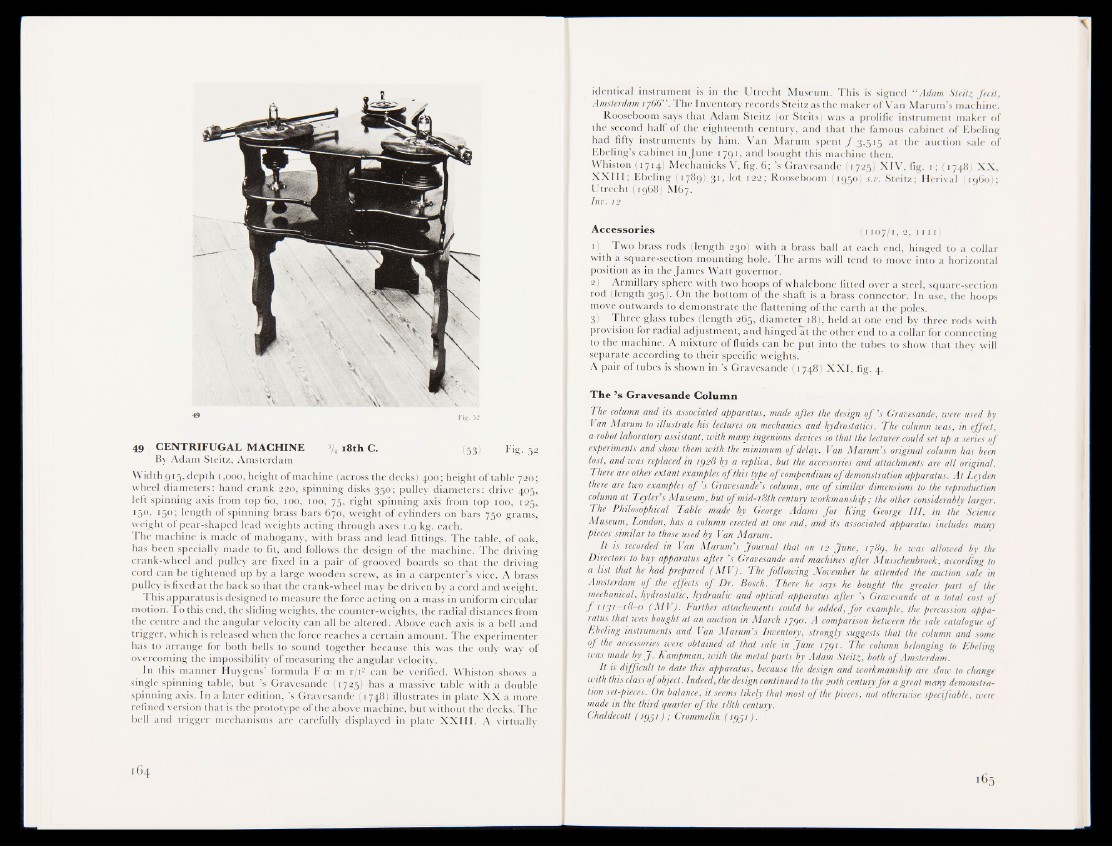
49 CENTRIFUGAL MACHINE % 18th C. ( | # ; Fig. 52
By Adam Steitz, Amsterdam
Width 915, depth 1,000, height of machine (across the decks) 400; height of table 720;
wheel diameters: hand crank 220, spinning disks 350; pulley diameters: drive 405,
left spinning axis from top 60, 100, 100, 75, right spinning axis from top 100, 125,
I5°> I5°! length of spinning brass bars 670, weight of cylinders on bars 750 grams,
weight of pear-shaped lead weights acting through axes 1.9 kg. each.
The machine is made of mahogany, with brass and lead fittings. The table, ||f oak,
has been specially made to fit, and follows the design of the machine. The driving
crank-wheel and pulley are fixed in a pair of groove« boards so that the driving
cord can be tightened up by a large wooden screw, as in a carpenter’s vice. A brass
pulley is fixed at the back so that the crank-wheel may be driven by a cord and weight.
This apparatus is designed to measure the force acting on a mass in uniform circular
motion. To this end, the sliding weights, the counter-weights, the radial distances from
the centre and the angular velocity can all be altered. Above each axis is a bell and
trigger, which is released when the force reaches a certain amount. The experimenter
has to arrange for both bells to sound together because this was the only way of
overcoming the impossibility of measuring the angular velocity.
In this manner Huygens’ formula Focm r/t2 can be verified. Whiston shows a
single spinning table, but ’s Gravesande (1725) has a massive table with a datable
spinning axis. In a later edition, ’s Gravesande {1748) illustrates in plate XX a more
refined version that is the prototype of the above machine, but without the decks. The
bell and trigger mechanisms are carefully displayed in plate XXIII. A virtually
identical instrument is in the Utrecht Museum. This is signed “ Adam Steitz fecit,
Amsterdam 1766” . The Inventory records Steitz as the maker of Van Marum’s machine.
Rooseboom says that Adam Steitz (or Steits) was a prolific instrument maker of
the second half of the eighteenth century, and that the famous cabinet of Ebeling
had fifty instruments by him. Van Marum spent ƒ 3,5x5 at the auction sale of
Ebeling’s cabinet in June 1791, and bought this machine then.
Whiston (1714) Mechanicks V, fig. 6; ’s Gravesande (1725) XIV, fig. 1; (r 748) XX,
XXIII; Ebeling (1789). 31, lot 122; Rooseboom (1950) s.v. Steitz; Herival (i960);
UtrechtHtg68) M67.
IniAi2
Accessories (1107/1,2,1111)
1) Tw^brass rods (length 230) with a brass ball at each end, hinged to a collar
with a square-section mounting hole. The arms will tend to move into a horizontal
position as in the James Watt governor.
2) Armillary sphere with two hoops of whalebone fitted over a steel, square-section
rod (length 3°5* On the bottom of the shaft is a brass connector. In use, the hoops
move outwards to demonstrate the flattening of the earth at the poles.
3) Three glass tubes (length 265, diameta\i8), held at one end by three rods with
precision for radial adjustment, and hingedal the other end to a collar for connecting
to the machine. A mixture of fluids can be put into the tubes to show that they will
separate according to their specific weights.
A pair of tubes is shown in ’s Gravesande (1748) XXI, fig. 4.
T h e ’s G rav e san d e Co lumn
The column and its associated apparatus, made after the design o f ’s Gravesande, were used by
Van Marum to illustrate his lectures on mechanics and hydrostatics, The column was, in effect,
a robot laboratory assistant, with many ingenious devices so that the lecturer could set up a series of
experiments and show them with the minimum of delay,: Van Marum’s original column has been
and was replaced in 192$ by a replica, but the a^CSCories and attachments are all original.
There are other extant examples of this type of compendium of demonstration apparatus. At Leyden
there are two examples o f ’s Gravesande’s column, one of similar dimensions to the reproduction
m>lumn at Teyler’s Museum, but of mid-i8th century workmanship; the other considerably larger.
'17/® Philosophical Table made by George Adams for King George III, in the Science
Museum, London, has a column erected at one end, and its associated apparatus includes many
pfammmilar .to those used by Van Marum.
It is recorded in Van Marum’s Journal that on 12 June, 1789, he was allowed by the
Directors to buy apparatus after’s Gravesande and machines after Musschenbroek, according to
a list that he had prepared (MV). The following November he attended the auction sale in
Amsterdam of the effects \of Dr. Bosch. There he says he bought the greater part of the
mechanical, hydrostatic, hydraulic, and optical apparatus after ’s Gravesande at a total cost of
f 1 r f .- i 8- o (MV). Further attachements could be added, for example, the percussion apparatus
that was bought at an auction in March 1790. A comparison between the sale catalogue of
Ebeling instruments and Van Marum’s Inventory, strongly suggests that the column and some
Wjf the accessories were obtained at that sale in June 1791 - The column belonging to Ebeling
was made by J. Kampman, with the metal parts by Adam Steitz, both of Amsterdam.
It is difficult to date this apparatus, because the design and workmanship are slow to change
with this class of object. Indeed, the design continued to the 20th century for a great many demonstration
set-piecC^ On balance, it seems likely that most of the pieces, not otherwise specifiable, were
made in the third quarter of the 18th century.
Chaldecott f 1991) ; Crommelin (1991 f ^